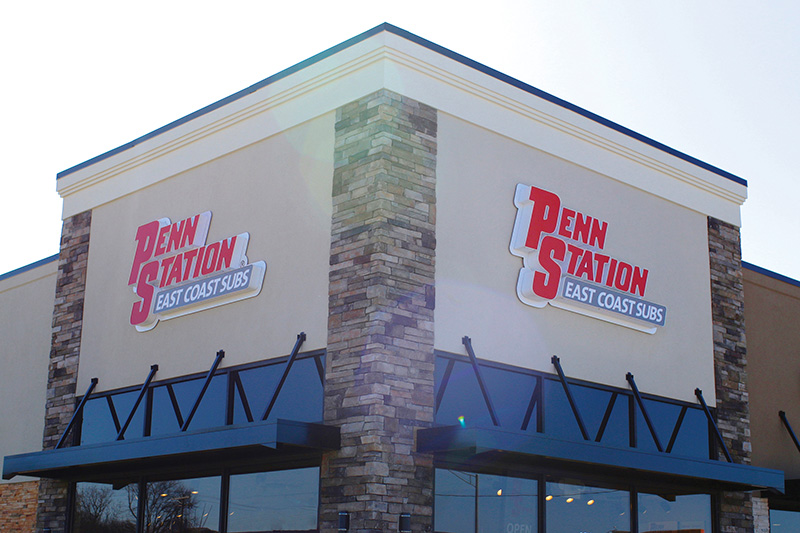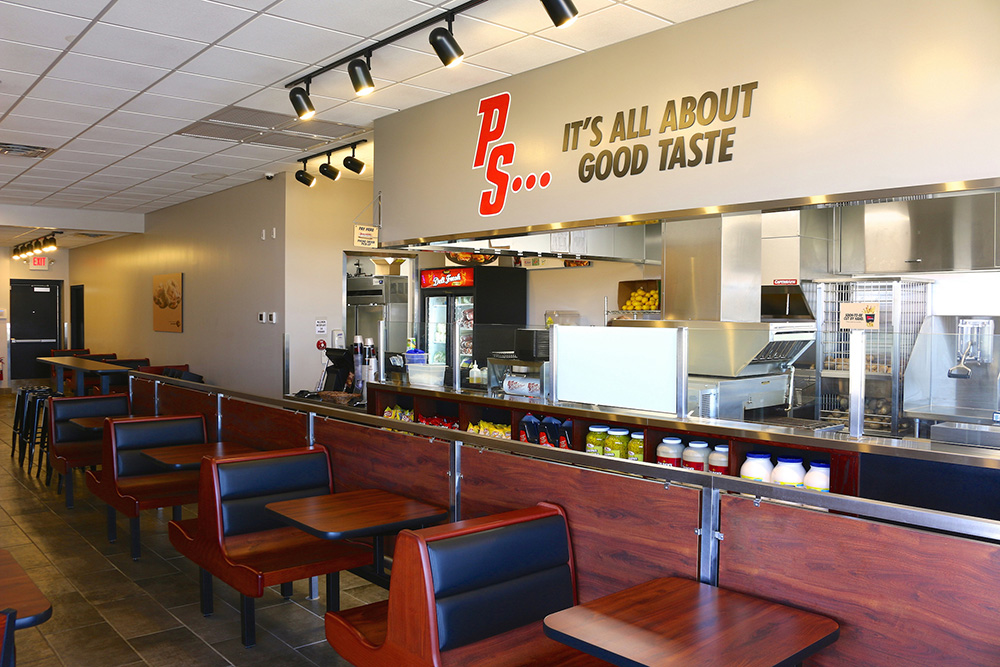How to create a cost-effective restaurant redesign.
By Craig Dunaway
Penn Station East Coast Subs sells America’s Number 1 Sandwich to consumers (according to the 2015 Nation’s Restaurant News Consumer Picks survey) and return on investment to franchisees. To this end, return on investment and profitability for franchisees are always top of mind in everything we do. Creating a new restaurant design is no different, but there are some unique challenges in updating a space while keeping the remodel costs effective. Here are six tips for keeping costs reasonable when creating a restaurant redesign.
Look at the Durability of Products
Products that last and are easy to maintain will save money in the long run. For example, Penn Station’s new restaurant design features light gray paint on the walls, which is an update from the older design’s wallpaper. Paint is a great option because it’s easier to maintain than wallpaper. Instead of having to deal with seams and bubbling as the glue ages, paint is simple to touch up. It’s also much easier to find a painter than a wallpaper installer. Franchisees were so excited about this part of the new design that many proactively updated their wall coverings prior to any remodel requirements.
 Aesthetics are an important factor in choosing design elements, but never forget function. Check the ratings for products like flooring. Tiles are rated for friction, and restaurants should always choose tile that prevents floors from becoming slippery. Penn Station chose a gray tile to brighten up the space, but more importantly, the tile is one of the highest rated on the market for resistance to liquids. Not only is the tile durable, but it exceeds the code requirements and will keep restaurants safer for customers if someone spills lemonade on the floor.
Aesthetics are an important factor in choosing design elements, but never forget function. Check the ratings for products like flooring. Tiles are rated for friction, and restaurants should always choose tile that prevents floors from becoming slippery. Penn Station chose a gray tile to brighten up the space, but more importantly, the tile is one of the highest rated on the market for resistance to liquids. Not only is the tile durable, but it exceeds the code requirements and will keep restaurants safer for customers if someone spills lemonade on the floor.
Use Design Elements That Are Also Functional
Nothing is more cost-effective than using a product to fill multiple objectives. For example, Penn Station added wood planking to the bottom 3 feet of walls in the recent remodel. The planking looks like hardwood flooring and helps warm up the space, but it also has a strict functional purpose. It protects the drywall and prevents holes and divots from chairs running into the wall or kids kicking it, helping the drywall last longer. As a bonus, the wood planking was easy and economical to install on walls.
Keep Old Elements That Still Look Great
Penn Station requires franchisees to remodel their restaurants twice in a 20-year term. In this process, however, there are different options to consider, and we allow franchisees to choose some of those options. If part of a restaurant has an older design that still looks and functions well operationally, Penn Station will allow a franchisee to decide if he wants to update that part of his restaurant. It’s a joint effort decision on cost/benefit versus what impact, if any, it might have on the overall consumer’s dining experience.
 Since franchisees remodel at different times, it’s important to keep restaurant redesigns in line with the original branding. Brand recognition is important, especially for small- to medium-sized restaurant chains. Every time you remodel, it should feel like the same restaurant and be consistent with other restaurants in the chain, even if they have older designs, while affording the customers something that continues to be both relevant and inviting to them.
Since franchisees remodel at different times, it’s important to keep restaurant redesigns in line with the original branding. Brand recognition is important, especially for small- to medium-sized restaurant chains. Every time you remodel, it should feel like the same restaurant and be consistent with other restaurants in the chain, even if they have older designs, while affording the customers something that continues to be both relevant and inviting to them.
Choose New Products That Make the Biggest Impact on Design
A restaurant remodel should create a fresh, new design and update the look and feel of the restaurant. Even while staying consistent to your branding, a redesign should incorporate new elements. Choose wisely and focus on changes that will give you the most bang for your buck. For example, Penn Station wanted to lighten up our restaurants with the most recent redesign. Gray paint and new gray concrete tiles were simple choices that would make the biggest change with the smallest cost to franchisees. Gray was also a great color choice because it goes well with most all design elements, thus helping with brand consistency.
Focus on the Parts That Are Most Important to Your Brand
Having an open kitchen has always been a huge part of Penn Station’s restaurant design. We want customers to watch as their sandwiches are grilled and their fries are cut by hand. As health codes have changed, it has become harder to make the kitchen visible to customers, so making sure that customers could watch as their food was prepared fresh was a huge focus in Penn Station’s new design. We added a three-foot wall combined with a 2-foot glass sneeze guard that allows customers to see the kitchen and protects the food for health codes. This shows off the freshness and made-to-order process of all of our unique products.
If something is critical to your branding, it’s an intelligent investment to spend a little more to make it work in your restaurant design. Being cost-effective doesn’t mean sacrificing brand standards.
Work With Your Suppliers
Good restaurateurs have a great relationship with their suppliers, and that can make a restaurant remodel much easier. If you know and trust your supplier partners, you can give them a direction with what you want to achieve and let them come up with examples and ideas that you can build on for a new restaurant design.
In general, cost-effective remodels require restaurants to prioritize what is most important in their design. From there, choose materials and products that are both functional and aesthetically pleasing, and never forget to factor in durability. If a product is inexpensive but needs to be replaced often, it won’t be cost-effective in a year or two when franchisees have to buy a new one.
Cost-effective remodels allow franchisees to spend more money growing their business and have higher profitability and return on investment. That’s key to a great franchisor-franchisee relationship.
— Craig Dunaway is president of Cincinnati-based Penn Station East Coast Subs, a fast-casual sandwich franchise with more than 300 locations in 15 states. For more information, visit www.penn-station.com.
